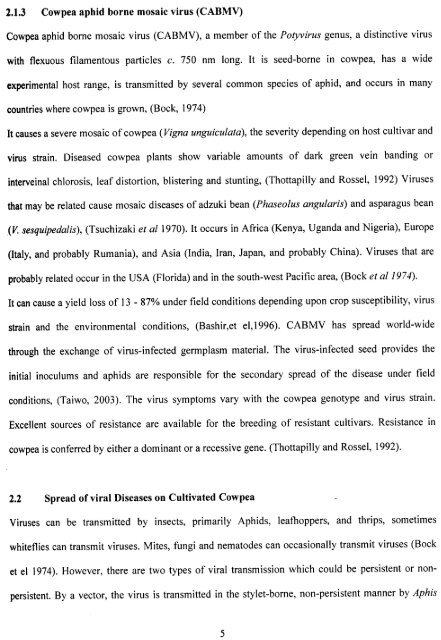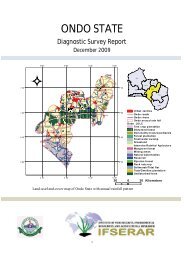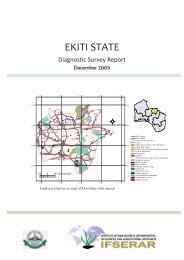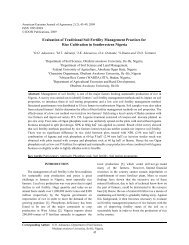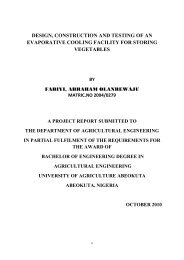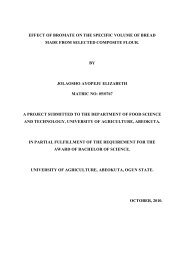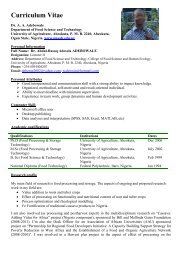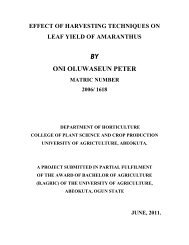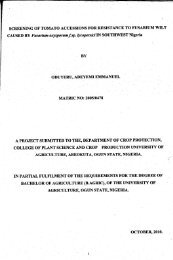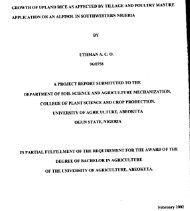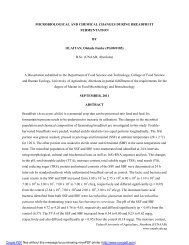TRANSMISSION OF COWPEA APHID BORNE MOSAIC VIRUS ...
TRANSMISSION OF COWPEA APHID BORNE MOSAIC VIRUS ...
TRANSMISSION OF COWPEA APHID BORNE MOSAIC VIRUS ...
Create successful ePaper yourself
Turn your PDF publications into a flip-book with our unique Google optimized e-Paper software.
2.1.3 Cowpea aphid borne mosaic virus (CABMV)<br />
Cowpea aphid borne mosaic virus (CABMV), a member of the Potyvirus genus, a distinctive virus<br />
with flexuous filamentous particles c. 750 nm long. It is seed-borne in cowpea, has a wide<br />
experimental host range, is transmitted by several common species of aphid, and occurs in many<br />
countries where cowpea is grown, (Bock, 1974)<br />
It causes a severe mosaic of cowpea (Vigna unguiculata), the severity depending on host cultivar and<br />
virus strain. Diseased cowpea plants show variable amounts of dark green vein banding or<br />
interveinal chlorosis, leaf distortion, blistering and stunting, (Thottapilly and Rossel, 1992) Viruses<br />
that may be related cause mosaic diseases of adzuki bean (Phaseolus angularis) and asparagus bean<br />
(V. sesquipedalis), (Tsuchizaki et al 1970). It occurs in Africa (Kenya, Uganda and Nigeria), Europe<br />
(Italy, and probably Rumania), and Asia (India, Iran, Japan, and probably China). Viruses that are<br />
probably related occur in the USA (Florida) and in the south-west<br />
Pacific area, (Bock et aI1974).<br />
It can cause a yield loss of 13 - 87% under field conditions depending upon crop susceptibility, virus<br />
strain and the environmental conditions, (Bashir,et el,1996). CABMV has spread world-wide<br />
through the exchange of virus-infected germplasm material. The virus-infected seed provides the<br />
initial inoculums and aphids are responsible for the secondary spread of the disease under field<br />
conditions, (Taiwo, 2003). The virus symptoms vary with the cowpea genotype and virus strain.<br />
Excellent sources of resistance are available for the breeding of resistant cultivars. Resistance in<br />
cowpea is conferred by either a dominant or a recessive gene. (Thottapilly and Rossel, 1992).<br />
2.2 Spread of viral Diseases on Cultivated Cowpea<br />
Viruses can be transmitted by insects, primarily Aphids, leafhoppers, and thrips, sometimes<br />
whiteflies can transmit viruses. Mites, fungi and nematodes can occasionally transmit viruses (Bock<br />
et el 1974). However, there are two types of viral transmission which could be persistent or nonpersistent.<br />
By a vector, the virus is transmitted in the stylet-borne, non-persistent manner by Aphis


